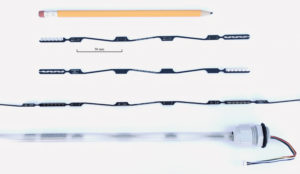APPLICATIONS OF TECHNOLOGY:
- Sensor array development, such as sensor tubes used for agricultural applications for infrastructure monitoring and land management (to assess snowpack properties, avalanche risk, road, levy, pylon, and building stability, and for the prediction of landslides)
- LED strips
- Power supplies
BENEFITS:
- Low production cost
- Locking design allows for mechanical robustness
- No components need to be soldered
- Vibration-resistant connector
BACKGROUND:
- Sensor probes, sensor arrays and LED strips require narrow cascaded printed circuit boards (PCBs). However, current solutions for interconnecting boards involve connectors or board-to-board soldering and therefore have a host of disadvantages (e.g., labor intensive, mechanically unreliable, expensive, bulky or require too much board space). To overcome such limitations, a new board-to-board connection technique was developed.
TECHNOLOGY OVERVIEW:
Researchers at Berkeley Lab have developed a method to interconnect PCBs. This technique does not require any components or soldering.
This method of cascading PCBs can be used in very thin sensor probes. The boards in these sensor probes can be assembled without using wires, but rather pins and slots on boards which are arranged at an angle so that electrical connections are formed. Through this PCB design, the board itself can be used as a connector. Notably, the design can be used for high-current applications and high-voltage applications. The technique provides a low-cost alternative to common connector technologies. It exhibits greater mechanical robustness than do previous methods, and it allows for ultra-narrow PCB designs. This is especially useful in applications where cascaded PCBs have to be placed in narrow tubes.
All designs were manufactured and tested through the development process, and contact resistance was monitored as a function of stress factors (e.g., temperature, mechanical) to ensure continuous operation. The final solution was selected for its reliability, ease of assembly, and connector locking.
DEVELOPMENT STAGE: Proven principle
PRINCIPAL INVESTIGATORS:
FOR ADDITIONAL INFORMATION:
SAMPLE APPLICATIONS:
- https://www.mdpi.com/1424-8220/22/7/2814
- https://tc.copernicus.org/articles/16/719/2022/tc-16-719-2022.html
STATUS: Patent pending.
OPPORTUNITIES: Available for licensing or collaborative research.


